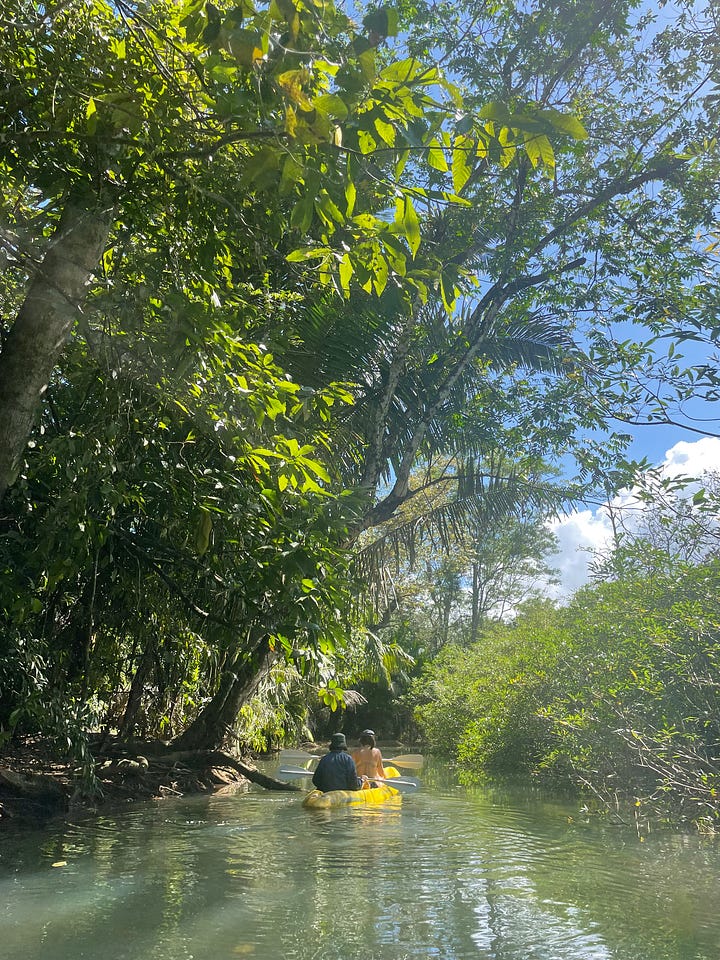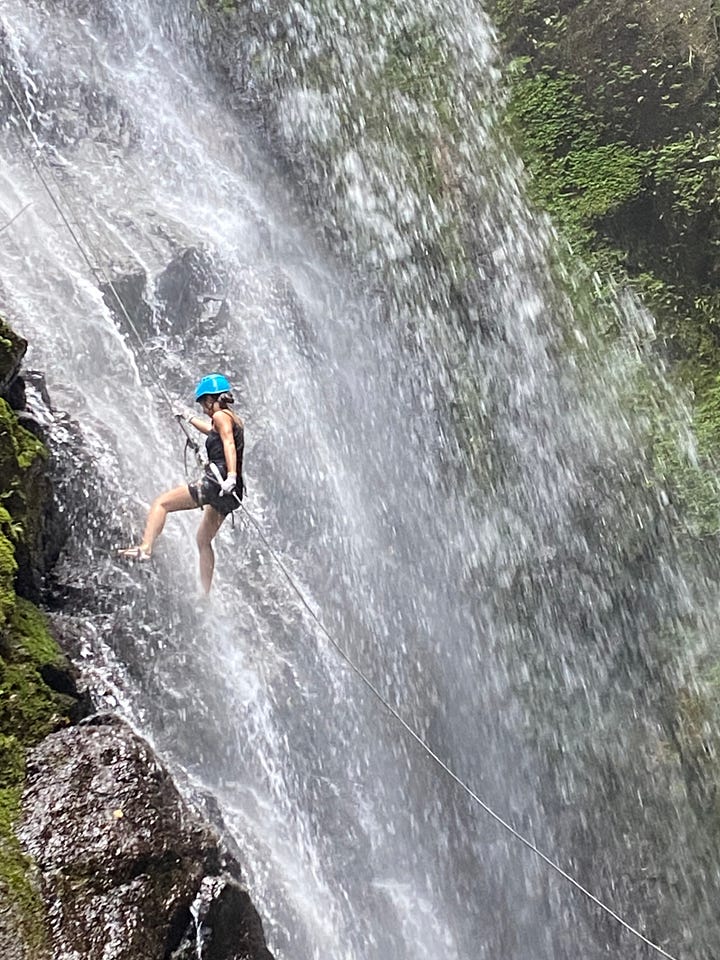sleeping under squirrel monkeys: christmas in the osa peninsula
a quick review because i delayed too long in writing this and lost some motivation
(part two of my three-pronged travels in costa rica, part one here)
My parents picked me up from my bee adventures at the San Jose airport. My brother Jacob wouldn't be joining us, for he needed to make his final preparations for his post-graduation motorcycle trip through Central America. What followed was a seven-hour drive south to the Danta Corcovado Lodge in the Osa Peninsula. Entering the coast and seeing Dominical felt like driving Maui's Road to Hana. As we got closer to the remote lodge, the humidity and calls of the jungle descended upon us with the sunset.
How did I choose the Osa? FOR SO MANY REASONS! To start, it’s one of the last places in Costa Rica to be settled. The National Geographic named it as "the most biologically intense place on earth." It houses 2.5% of the biodiversity of the entire world, while covering less than three millionths of its total surface area. Here, you can find all four species of Costa Rica's primates, the largest population of scarlet macaws in Central America, and the most significant wetland ecosystem and mangrove forests of Central America. It is separated from the mainland by the Golfo Dulce, which is one of four tropical fjords in the world, and the "only place on the globe where populations of both Northern and Southern Humpback whales meet to birth their young" (you can find more facts here).
Compared to other lodging in Puerto Jimenez, Drakes Bay, and in between, the price of Danta was super reasonable for a family to stay (like, 2-3x cheaper, $100 a night). I'm grateful to my parents for joining me for the holidays here, because I wouldn't have been able to afford any lodge in the Osa if I were alone.
I loved the food at the lodge, but my favorite part was being so close to nature. Your proximity to nature begins right at check in, when you receive a flashlight that you must use after dark to reach your cabin via an unlit gravel trail. The cabin has a half-open roof that lets you hear the jungle well, especially at night. We often sat on the patio outside, and one day, howler monkeys showed up right in front of us, their hoots rivaling the sound of the heavy rain. It was amazing to see the wonder light up my dad's face.
Every night, a group of 30-40 squirrel monkeys would jump from tree to roof to pole near the lobby, taking the same journey to the top of a tall palm tree, where they could sleep safely each night, huddled together in a row. It was also amazing to spot the birds sleeping at night, camouflaged underneath large leaves. One of these sleeping birds was the Michael Jackson bird.
Tours Organized by the Lodge


First, my dad and I went on a kayaking trip in the Golfo Dulce, paddling deep into the mangroves. At the turnaround point, we stood knee-deep in the water and drank from tiny pipa coconuts. On the way back, we passed under another troop of curious squirrel monkeys, who performed a death-defying acrobatics show, jumping across the water and flopping onto treetops. Back on shore, our guide led us to a sloth resting in a tree. We also heard our first scarlet macaws flying overhead. They mate for life and always travel in pairs.
The next day, we took a boat trip to the Golfo Dulce again. We learned from our guide that the Golfo Dulce's depth, calm waters, and relative lack predators turn it into a sort of dolphin and whale kindergarten. While it wasn't whale season then, we did get to spend several hours alongside a mother and son dolphin as they swam around looking for breakfast. Our guide knows the dolphin population so well because he helps with longstanding dolphin and whale research projects through the Center for Cetacean Research of Costa Rica.
On one morning, we took a massive tractor through river crossings and pits of mud to reach a hike in the Corcovado National Park. We were one of the first groups to visit this entrance, because Costa Rica's incredibly long rainy season, caused by climate change, made the roads impassable to regular cars. Our guide Juan Luis told me about his favorite poets, Julian Marchena and Jorge Debravo.
Here’s one of Marchena’s poems, Vuelo Supremo:
Quiero vivir la vida aventurera
de los errantes pájaros marinos;
no tener, para ir a otra ribera,
la prosaica visión de los caminos.Poder volar cuando la tarde muera
entre fugaces lampos ambarinos,
y oponer a los raudos torbellinos
el ala fuerte y la mirada fiera.Huir de todo lo que sea humano;
embriagarme de azul… Ser soberano
de dos inmensidades: mar y cielo;y cuando sienta el corazón cansado
morir sobre un peñón abandonado
con las alas abiertas para el vuelo.
We also got to tour a multi-crop sustainable farm that focuses on cacao, Finca Kobo. We saw:
A large soursop hanging from a tree. They’re the most expensive fruit in Costa Rica.
A coffee flower, which has a beautiful smell, a mix of gardenia and citrus.
A white pineapple! They are the oldest pineapple species and are actually tastier. Companies mass-produce the yellow ones because they look better.
The farm’s owners, Alex and Jutta, have an inspiring mission:
"We are looking for a way to survive as farmers but at the same time develop a less exploiting form of production. We want to create a place, where the protection of the soil, the water, and both ecosystems – the agricultural and the natural one surrounding it may be combined with profitable farming. Thus, allowing for a healthier place for humans as well as for their surroundings.
We believe that production is closely linked to conservation. As a farmer, I think we have to establish places and structures within our farms to leave some space to nature.
At the moment we are working on creating various different agricultural ecosystems. Diversity is our best asset in this task. Our crops are organic. We use biological fertilizers such as compost or manure. We also experiment with plants for pest control."
Other highlights of Danta tours included learning about the Ngöbe indigenous group's history, traditions, and lifestyle on a Spanish-only tour, where I successfully translated the whole time for my parents, and spotting a rare Montezuma oropendola bird on an early morning bird walk.
Finding Our Own Adventures
We exhausted Danta’s tour offerings within the first 4-5 days of our stay, so I found some activities to fill out the rest of our week. In retrospect, I think we could have split the week between two areas of Corcovado, spending half the time near Puerto Jimenez and half the time near Drakes Bay. This would let you see different areas of the park! We only got to explore around the Los Patos station, but you can also enter via the more popular Sirena and La Leona stations.
After fixing a Christmas Day flat tire in town, we drove an hour south to Rancho Tropical for an unforgettable afternoon of horseback riding and rappelling down a waterfall. I befriended my horse Coco, especially because Coco was my name in high school Spanish class. Coco kept looking back at me with sweet eyes and was so well behaved. We climbed steep rocky trails on the horses, then walked a bit farther, in order to reach the waterfall. I was the last to go down, and definitely the slowest, since it was my first time rappelling. My Tevas were so slippery on the top of the waterfall that I thought I would fall off. The instructor at the bottom shouted instructions to help us maneuver from side to side as we walked down. Looking back at the pictures later, I felt like a real-life Lara Croft. I bonded with the mom of the other family on the tour, and she asked me to join their family photo at the end 🤣.
On the way back, I felt comfortable galloping on a horse for the first time. Coco and I ditched the group at the end, sprinting across a green field during golden hour. I returned to the stable awakened, an adult horse girl.


On our last full day, my mom and I went to the Bolita Rainforest Hostel to go hiking. For $10, you get lifetime access (not sure how they verify this) to their 15km of trails in the jungle, right at the border of the Corcovado Park. We hiked across a river and up a mighty hill to the actual hostel, which has no internet and a nudist zone. After fueling up on water there, we went on a beautiful hike with views of the valley, finding morpho butterflies along the way. We picked up some delicious coconut ice creams in plastic bags from a woman who sells them out of her house in the town.
Lessons in the Osa
After leaving the Osa, I watched a documentary called “2.5% — The Osa Peninsula” that explored the possible environmental and social impact of opening an international airport in the region. It showcased the importance of teaching indigenous communities valuable skills, instead of coming to preach conservation, donating money, and leaving. The area is very poor, and it is hard to find work outside of tourism. The documentary talks about how the government banned panning for gold in the area when that was a large source of people’s livelihood. To address these problems, the film advocates for giving locals the capacity to benefit from the tourism industry instead of having foreigners own everything.
Here are two quotes that I took away from the documentary:
"What we are doing to the forests of the world is but a mirror reflection of what we are doing to ourselves and to one another" -Mahatma Gandhi
“Rural tourism can unite a community around a low-impact commercial activity, where everyday life becomes a tourism product , where a new value is given to the milking of a cow, picking corn, or cooking a meal. If can we give the every day new value, like the presence of birds and all the other animals, people begin to hunt less. Because a living animal that tourists can see is worth more than a piece of meat. A blooming tree is worth more than its lumber. Birds singing in the wild are worth more than having a cage full of birds.” - Gino Biamonte




